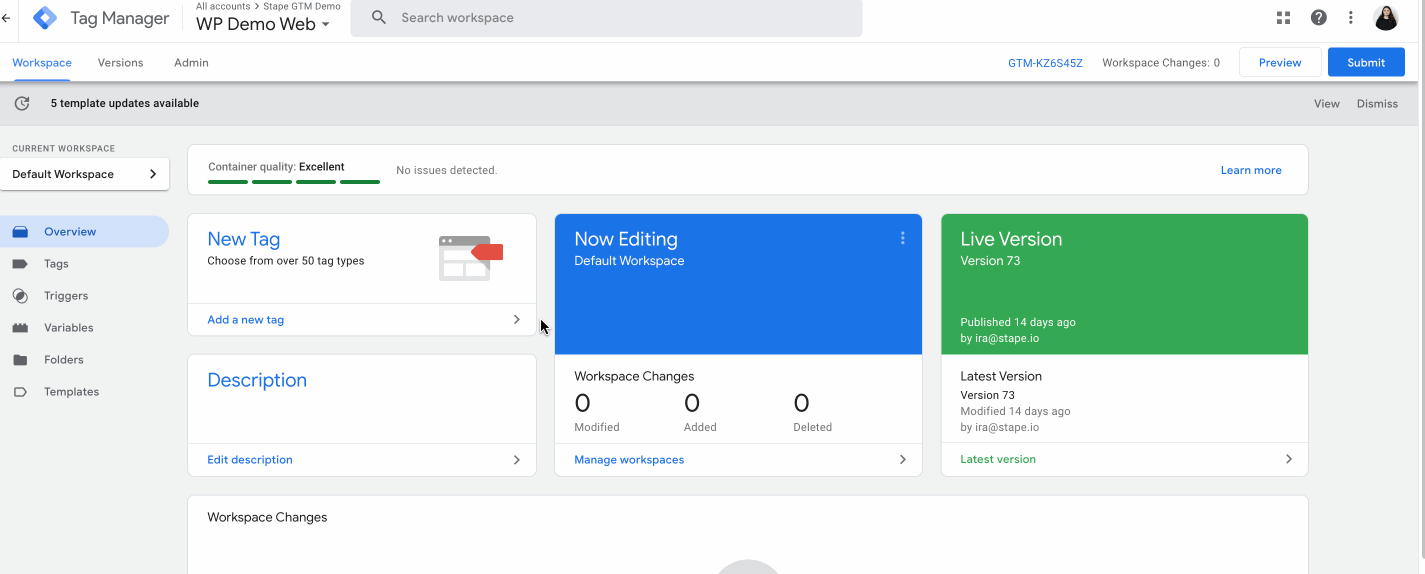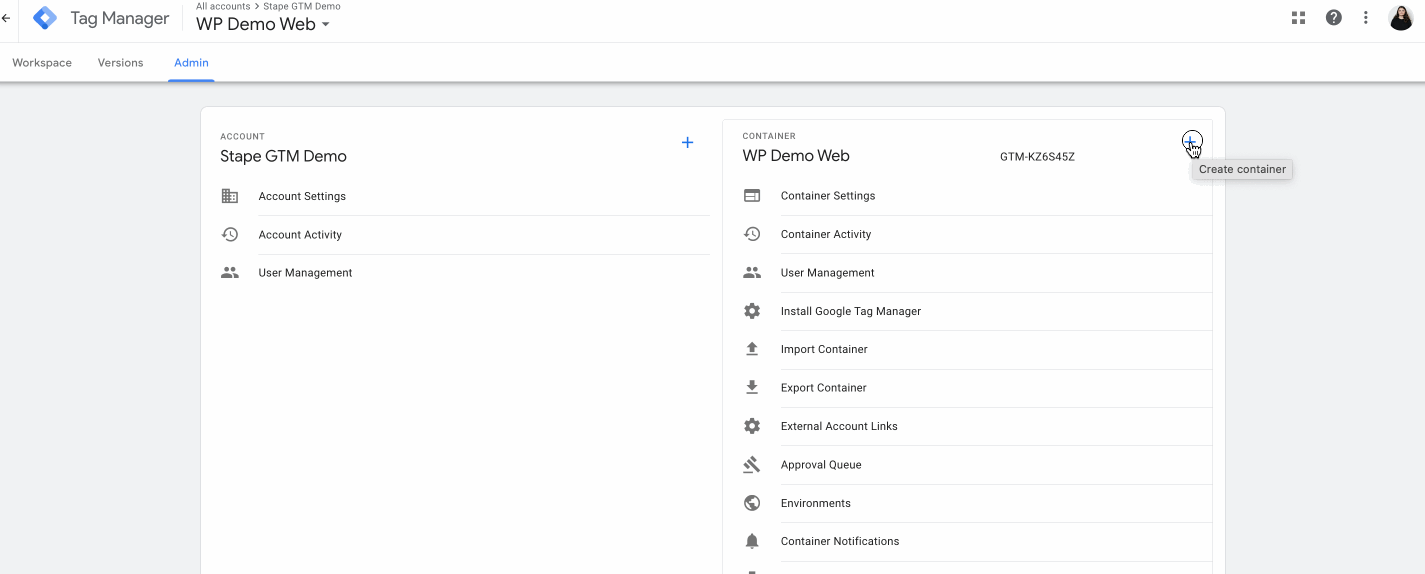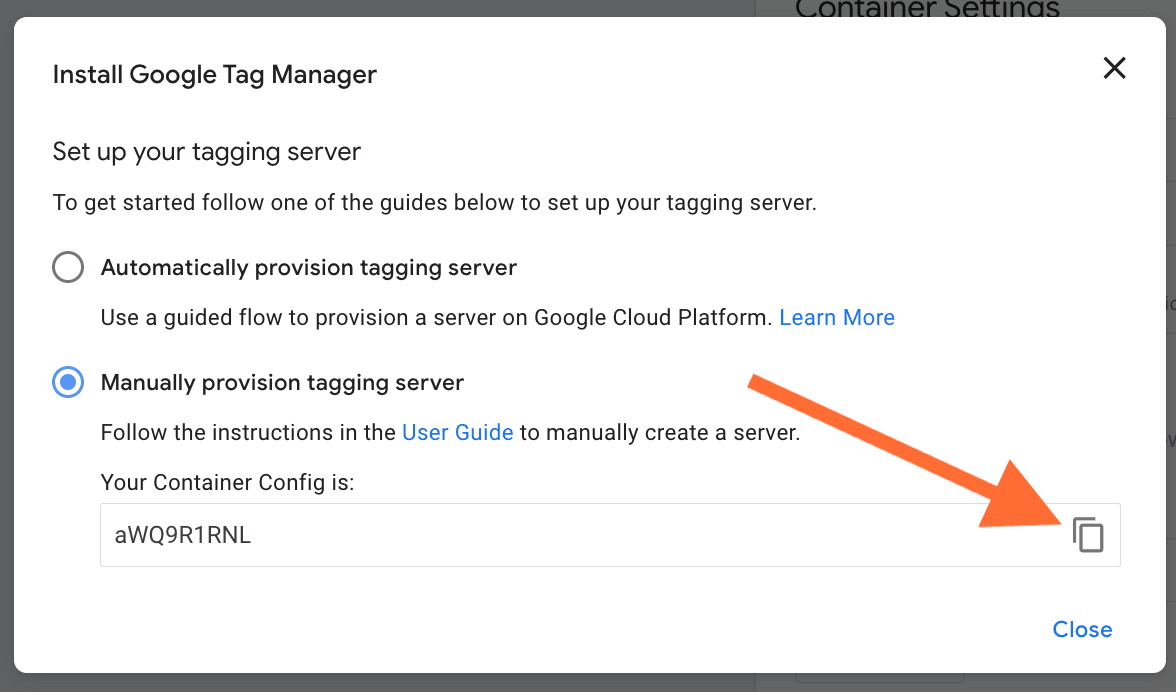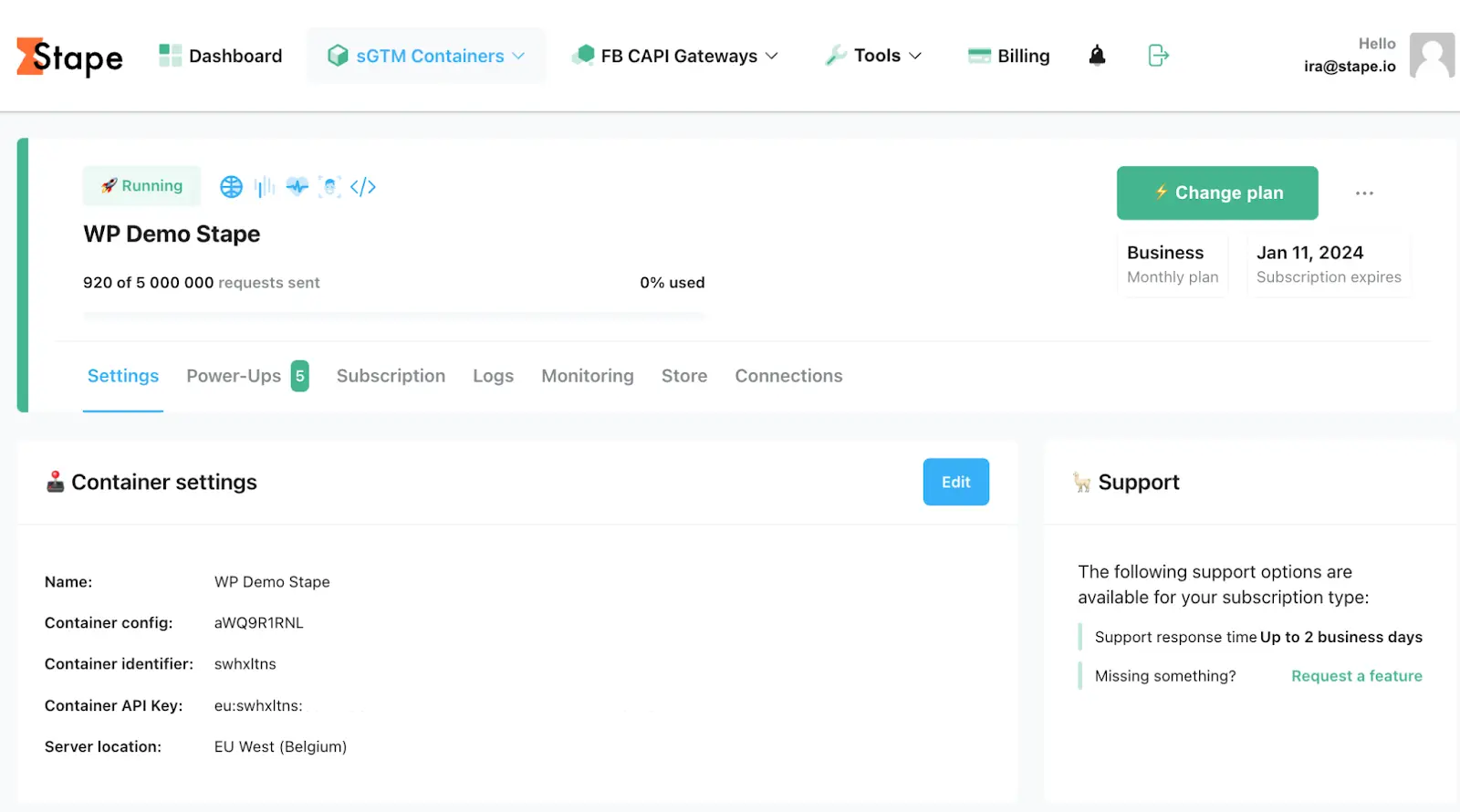1.1. Open your WEB Google Tag Manager container.
Click Admin. Under the container column, click +

1.2. Type the container name, choose Server, and click Create.

1.3. Choose Manually provision tagging server, copy your container config and paste it in any text editor. We will need it for the next steps.

1.4. Create a Stape account or log in to your existing one.

1.5. In Stape’s admin dashboard click Create container on the top right.

1.6. Enter your container details:
Then click Create Container.

1.7. Choose a plan for your container. You can start with a Free plan.

1.8. You will see the status of your container, container config, and plan name.
It takes around 5 minutes to deploy a server container. Please reload the page to update the status. If the Google Tag Manager server-side setup was done correctly, you should see the status “Running”.

| Custom Loader modifies gtag.js and gtm.js loading paths to resist ad blockers and ITPs, potentially increasing data volume by up to 40%. |
2.1. Find and copy your WEB GTM ID in GTM.
To find GTM ID log in to your Google Tag Manager account and open a Web GTM container. In the top right corner (next to the Submit and Preview buttons) you’ll see some short text that starts with "GTM-" and then contains some letters/numbers.

2.2. Open your sGTM container on Stape → Click Power-Ups.
Find Custom Loader and click Configure.

2.3. Add the following settings:
Domain - from the list of domains connected to your container, select the necessary ones.
Web GTM ID - add web Google Tag Manager ID. Check out how to find web GTM ID in our guide.
GA4 ad block bypass - enables bypassing adblockers' impact on the GA4 tracking code. Note that this setting will affect all container domains. Be sure to debug both the web and server GTM containers after enabling this toggle.
Same Origin Path - if you are using same origin approach for configuring custom domain, please specify the proxy path for requests. Learn more.
Platform - the custom loader code differs for each platform. Select Wix, click generate and follow the steps on the right.

You can also select another new platform in the Custom Loader setup besides Wix - Prestashop. The setup is similar:

3.1. Go to Wix App Market and choose Stape Conversion Tracking app.
Click “Add to Site”.

Log in to your Wix account and download the app for free!
3.2. Configure settings in three tabs: General Settings, DataLayers, and Webhooks.
3.3. General.
This tab contains all the options for configuring the GTM snippet installation on every page of your Wix site.
Add the following data:

3.2.2. Data Layers.
In this tab, you can find toggles that enable dataLayer events. With their help, you can enrich the data by adding product and user information.
The “Append _stape suffix to event” option is a new setting that lets you choose whether Data Layer events get the _stape suffix. When it’s turned on (default), events will look like purchase_stape or view_item_stape, which helps keep Stape events separate from your existing GTM setup and avoids naming conflicts. If you turn it off, events will use their normal names, like purchase or view_item.

3.4. Webhooks.
Here, you can configure the webhooks to be sent to a specified URL for different events, such as purchases and/or refunds.
All you need to do is to add the URL of your server container (format: https://sst.example.com/data).
Turn on the fields according to the type of event - purchase and/or refund.
Check out the blog posts on using and debugging webhooks:
Click “Send text webhook”.


4.2. You should import the templates in both your web and server container on GTM (process is the same across the two). You need to go Admin → Import Container:


4.3. Select your template file (make sure the template matches the container type - web/server).
4.4. Pick a workspace for this import (you can create a new one for this specific purpose).
4.5. Select Overwrite or Merge.

| “Overwrite” option should only be used in a fresh, empty container or if you are absolutely certain you want to do it. For this demo we’re using Merge, with “Rename conflicting tags, triggers and variables” option selected. This way, if there are any conflicts - GTM will just rename the tags, thus not touching any of the existing entities you have in your container. |
5.1. Templates are fully built, so triggers, payloads, and event names are all taken care of for you.
You just need to input your specific destinations, ids, API keys etc. We’ve tried to make it as comfortable as possible, so in both containers (web and server), you will find a folder called “[Stape] _Settings”.
Web

Server

All these variables are already referenced in tags that use them; you just need to give them proper values, for example:

5.2. Pixel ID and API token can found in your pixel settings:


5.3. Once you’ve changed all these variables and saved them, your last step (assuming this a new container) is to add a preview URL in your server container by going to Admin → Container Settings. If the container is not new, just skip this step.

Facebook provides the ability to test Browser and Server events. That is very useful if you set up Facebook pixel using GTM Server for the first time and wish to check that all data tracked correctly.
6.1. First, you need to obtain test_event_code. For this, you need to log into your Facebook manager, choose the data source that you liked to test, and open the tab “Test events”. There you will find the test event code. It can look like this: TEST2120

Note: TEST id will change once in a couple of hours, if your debug sessions are spread in time make sure to check the value you’re using is still valid.
6.2. Fill the LT - Map | Debug Mode → FB Test ID variable, in your server container, with the test event code that you get from the previous step.

This variable is already referenced in all Facebook tags. Variable will also only populate the tag in preview mode, so you don’t necessarily need to remove it before going live.
6.3. Launch preview mode on both your containers (web & server) If done right, you will see both web and server test events on the Facebook Test Event page.

| Additional reading: this Wix ads guide shows the main ad types, placement ideas, tracking basics, and realistic revenue ranges. |
We're happy to hear that! Click on Try for free to register and check Stape's benefits.
Comments